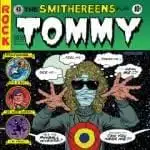
Why?
This is the question every Smithereens fan—and every fan of The Who—must ask when listening to The Smithereens Play Tommy. It is common knowledge that Tommy is terrific, full of songs worth playing. And it’s common knowledge that The Smithereens—a briefly big power-pop outfit from North Jersey that had a small string of hits and fine albums in the 1980s—are a band deeply in love with the British Invasion.
So, we can understand why The Smithereens would want to make a song-for-song re-recording of Tommy. But, critically: Why did they actually do it?
This is not meant as a rhetorical way of saying that it stinks. It doesn’t stink. The Smithereens, packing dosed-up guitars that ring with power and full-throated singing, are up to the task of playing Tommy. The band, in short, sounds a whole lot like The Who. This is an accurate, respectful—too respectful—recreation of a classic.
So, again, why?
Let me venture an answer: business.
In 2007, Pat DiNizio (lead vocals and guitar) and his band released Meet the Smithereens, a track-by-track cover of Meet the Beatles. It was followed within a year-plus by B-Sides – the Beatles, a collection of less common tunes by the Fab Four. On the backs of these heartfelt but relatively unadventurous tributes, The Smithereens toured small theaters all over the country, playing their hits, sure, but also playing these ringingly familiar classics to receptive ears. It is ingenious, really, because releasing new albums of original music and hoping that the new music will be received happily by the band’s now-middle-aged fans is nearly hopeless. Instead, why not lay legitimate claim to playing both your own music and “your” Beatles tunes?
And, now: Tommy too.
Covering these classic Who tunes, there is too little sense that the songs have been remade in the style of The Smithereens. DiNizio’s voice is distinctive, with a downbeat tone that made even the most hopping Smithereens tunes sound doomed. On the Beatles material, his vaguely nasal baritone was often enough to color the covers as distinctive. Here, however, the band recreates Roger Daltrey’s lead vocals in Daltrey’s tenor range, high and often straining some against the edge. As a result, the vocals become more anonymous when they are more urgent.
“Amazing Journey” is, of course, a great tune. And The Smithereens turn up their amps and rock it with pleasure—but it sound just a heck of a lot like the original. It’s not eerie, perhaps, but it’s curious. The opening strains of the classic “Pinball Wizard” give you that thrill as always, with the quick-strummed acoustic guitars giving way to an electric lick. The vocals—particularly the stacked harmonies of “Sure plays a mean pinball!”—should feel distinctive and different. But they sound like they come from guys who have listened to Tommy soooo many times that, . . . well, they just can’t help but sound like Daltrey, Townsend and Company. And they do.
A few tracks take on a pleasantly Smithereeny sheen. “Acid Queen” is absolutely outstanding, with DiNizio sounding just like himself, glowering a bit as he lays out the verses, remaking the tune not only in the vocals but also in how the arrangement is layered in the brief bridge. And there are flashes in other songs. “Go to the Mirror” has a pleasant Hoboken roll to it, genuinely improved with a little bar-band DNA strapped into its groove. “Tommy Can You Hear Me” is strummed out in harmony over acoustic guitar, and it sounds different than The Who—for its quick minute. “Sensation” is largely mimicry, but “I’m Free” gets a little closer to being a genuine cover as DiNizio intones the song’s title without the covering harmony.
For the most part, however, it’s hard to imagine listening to The Smithereens Play Tommy more than once without asking yourself, “Well, why don’t I just listen to the REAL Tommy? Loyal to the original to a fault, this record does too little to distinguish itself.
It does, however, justify the ‘Reens playing some Tommy in their live shows. And you can probably see them, these days, for a song. And you’ll get some “All My Lovin'” and “You Can’t Do That” thrown in—not to mention “A Girl Like You” and “In a Lonely Place”.
The call is simple: saver yer money now, put on a leather jacket when the ‘Reens come to town and remember that those E Street guys are not the only great Jersey band to have a hit during the ’80s. See them, hear them, touch them. That’s why they made the record anyway.
